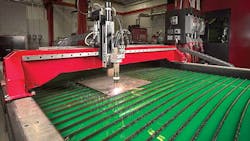Why plasma process is on the cutting edge
TRAILER fabrication involves production of parts in all shapes and sizes from various steels or aluminum. One process, plasma cutting, can perform that work quickly and reliably. Advances in plasma technology and the introduction of automation into the equation make this a reality.
Plasma cutters work by sending an electric arc through a gas as it passes through a constricted opening. The gas can be shop air, nitrogen, argon, oxygen, etc. The arc elevates the gas temperature to the point where it enters a fourth state of matter – plasma. Because the metallic material being cut is part of the circuit, the plasma’s electrical conductivity causes the arc to transfer to the work.
Because the process uses the workpiece as part of the electrical circuit, plasma can cut any material that conducts electrically, including carbon and stainless steels, aluminum, copper, brass and titanium, among others.
Plasma cutting most frequently competes with oxyfuel, waterjet and laser cutting among fabricating processes.
Oxyfuel cutting works by using a gas to heat the workpiece, followed by a stream of oxygen that oxidizes and disperses the metal. While ideal for carbon steels, the oxyfuel process cannot cut stainless steel or aluminum, as stainless will not oxidize, and aluminum oxide melts at a higher temperature than aluminum.
Waterjet cutting, while providing precise cuts, is much slower than automated plasma cutting. A part that may take an hour to cut on a waterjet can be created in only minutes using a plasma cutter.
Laser cutting is another option that offers very precise cuts, and is generally much faster than waterjet or oxyfuel. However, as workpieces surpass about ¼ inch in thickness, plasma cutting becomes much quicker, and at a lower capital machinery investment.
Clearly, plasma cutting brings money-saving cycle-time and overall productivity improvements during the cutting process. Consumable use is another cost consideration and depending on the application, plasma cutting may win here, too. System manufacturers can provide estimates on consumable use and expected pierce life for various applications.
Beyond speed improvements, plasma cutting proves beneficial when comparing startup and operational costs for fabricators who cut a variety of materials. For example, a good-quality waterjet machine may cost roughly the same as that of a plasma-cutting machine, but the maintenance and consumable abrasive costs can prove to be much higher. Conversely, a high-wattage laser setup can be three to four times the initial investment when compared to precision plasma.
Flexibility is the key, however. Plasma-cutting machines provide precise cutting, especially as workpiece thickness increases, and can work with a variety of materials. You don’t need a waterjet for aluminum and an oxyfuel torch for steel; instead, you can do it all with one plasma-cutting system.
Not Your Father’s Plasma Cutter
Plasma cutting debuted in the early-1960s in the industrial sector. Fabricators using it soon noticed the benefit in being able to burn both ferrous and nonferrous materials. While equipment underwent improvements over the years, many still see plasma cutting as an old, dingy process. However, that’s not the case these days.
Today’s automated plasma-cutting systems are available in many sizes, with tables stretching to 120 feet or more – a plus for fabricators in the trailer sector who need tables long enough for producing trailer rails and other long parts.
Unlike older models, modern cutting systems feature precision plasma torches and precision CNC controllers. Advancements in these areas enable these systems to deliver high-speed, customized work. Software enables drawing, importing and storing of parts, and editing of part files to create one-offs or part families, such as similar panels with varying numbers of bolt holes. Software also optimizes part nesting on the workpiece. The most advanced machines nearly eliminate beveled edges and deliver parts to exact specs if tolerances are within 0.005-0.01 inches.
Automation improvements also have flattened the learning curve, bringing systems on line more quickly and allowing operators to produce higher-quality parts with less training. For a new plasma-table installation, training for an operator to cut good parts is one to two days max, thanks to the help of controller software in these modern systems.
The science behind plasma cutting has improved — and simplified — over the years. Today, you simply need to draw the part and load it into the controller, indicating the material type and thickness. The controller software sets the optimal settings for the material and thickness input into the system and then selects the optimal amperage for the material thickness. It also automatically sets the different gases needed to cut for the material type, as well as torch height. The result is the best possible, most precise cut quality.
Software even addresses a traditional shortcoming of plasma-cutting systems: hole quality, especially where hole diameter nears material thickness. Before, cutting a 1-inch hole in 1-inch-thick carbon steel would require secondary drilling to drop through a 1-inch bolt. Not anymore. Software from Lincoln Electric, for example, automatically loads all of the parameters for obtaining the best hole quality into the controller for that part, and the system adjusts to do just that. Where the part perimeter may be cut at 65 inches per minute, the hole may cut at 40 inches per minute with a different cutting height, lead in and lead out geometry, and gas pressures, for example. It’s all done automatically, and eliminates a costly, time-consuming secondary operation.
Improved aluminum cutting
The quality of aluminum cutting using plasma has improved tremendously. Previously, due to the common practice of using shop air as the cutting gas, edge quality on aluminum cuts suffered. But technology advancements and research into alternative gas options, now allow higher-quality cuts at higher speeds than ever before. Many fabricators first consider waterjet systems when working with aluminum, but a little research will show that plasma cutting can often produce the part quality to meet their needs, and do so in significantly less time.
When cutting aluminum on a plasma system, many machines use downdraft systems or fans to cut the noise and smoke encountered. Filling the bed with water is another option to absorb the noise and smoke. If you use water, it is important to note that as the aluminum is cut and the slag falls into the water, the material breaks down water molecules and releases hydrogen. Hydrogen bubbles can form under plates in the water and create a dangerous situation, especially when the machine is powered back up after sitting idle for an extended period. For this reason, agitators must be used to move the gas around the edges of the plate, allowing it to escape into the atmosphere.
Yes, plasma cutting has come a long way. Automated systems, with the latest in CNC controls, software and plasma technology, offer new levels of flexibility that make plasma cutting the perfect addition for trailer fabrication. ♦


